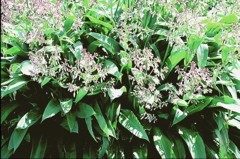
Euphorbia characias 'Oliver'
Remarkable new euphorbia bred by us, with compact mounds of greyish green pewter foliage, lime green flowers spotted red. Wonderful foliage plant for landscaping with miscanthus, sedums, and westringia.


The lush green leaves resemble the foliage of a Hosta and look great in mass plantings beneath trees. New Zealand native with sprays of starry white flowers in summer.
The lush green leaves resemble the foliage of a Hosta and look great in mass plantings beneath trees. New Zealand native with sprays of starry white flowers in summer.
Data sheet
Remarkable new euphorbia bred by us, with compact mounds of greyish green pewter foliage, lime green flowers spotted red. Wonderful foliage plant for landscaping with miscanthus, sedums, and westringia.
Sweetly fragrant variety with pink feathered flowers and silver cushion forming foliage.
Brilliant new variety with dark foliage ; strength and upright growth habit of 'Matrona' but the darker foliage of 'Purple Emperor' and red flowers.
White form of the blue 'speedwell', just as easy as the blue form. Both varieties are semi deciduous and respond well to cutting back.
Rich pink variety, easy cottage garden plant flowering in autumn. Combine with ornamental grasses and sedums.
Old fashioned 'shasta daisy' with tall strong stems for picking, bullet proof plant that is reliably perennial and will grow almost anywhere.
Cushion plant suitable for thyme lawns, trough, and rockgarden plantings with pink flowers. Aromatic when crushed.
Old fashioned white 'cup and saucer' type, easy and clumping like other persicifolia types; only few in stock.
Taller salvia for background plantings with pleasant sky blue flowers. Dislikes winter wet, preferring drainage for best cultivation.
A terrific subulata ground covering variety, hundereds purple flowers in spring an a good groundcovering habit, likes some drainage but not overly fussy and can tolerate drying out in summer..
'Lily of the valley'. Clump forming and easy perennial for shade or part sun, sweetly fragrant bells in spring.
Useful and prolific evergreen ground cover, flowering in winter and spring. Clear blue flowers, useful as mass plantings.
Huge ornamental rhubarb from Brazil, suited to pond, bog, and streamside plantings. The leaves can be 1.5 - 2.5 m across, on stems up to 2.5 m in sheltered conditions.
Reputedly more blue than others, we find these echinops, contrary to their appearance, are best situated in a cooler position with only part day sun. To yield their best, plant in fertile drained soil and a sheltered position.
A wonderful Geum kept in circulation by Dennis Norgate; vibrant tangerine orange, repeat flowers throughout the year and non seeding.
Himalayan species, with attractive pink stems & foliage. The lime green flowers form an interesting contrast.

The lush green leaves resemble the foliage of a Hosta and look great in mass plantings beneath trees. New Zealand native with sprays of starry white flowers in summer.